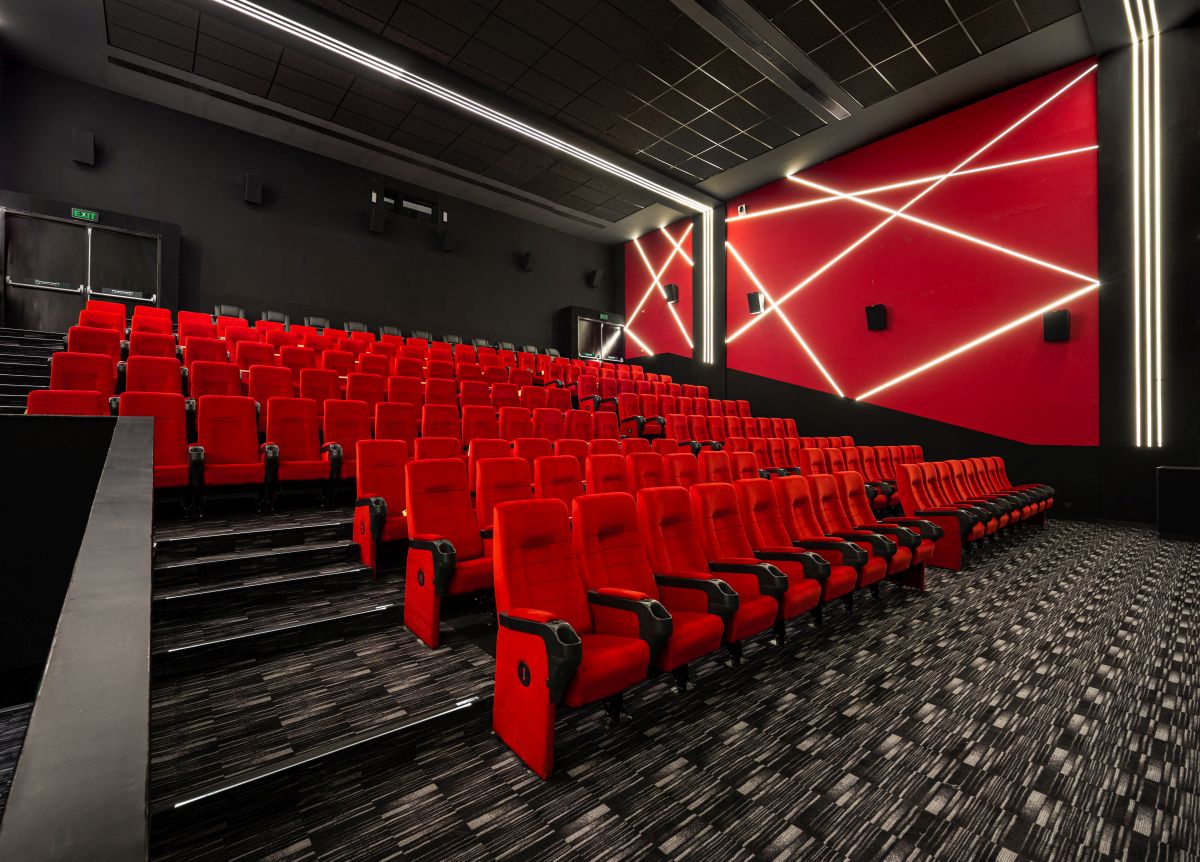Sync Design Studio is a Gurugram based design studio that specializes in consumer-centric architecture layered with a collaborative and holistic approach. Founded by a team of a young, self-motivated group of architects, the studio recently stood out for its multiplex project located in sector 90, Gurugram.
Design and Concept
The Lit Boscage is featured opposite a food court on the third floor of the open-air Sapphire Ninety Mall. Considering the mushrooming entertainment landscape in Gurugram’s corporate hub, the multiplex offers a unique and differentiated user experience. The conceptualization began by analyzing and studying the growing demand for a significantly distinct multiplex identity despite the mainstream functionality of the structure.
True to the name and deeply inspired by the alluring quality of a forest, the design interprets the characteristics of the foliage of a tree into linear geometry. The clean, glass façade especially emulates the enticing factor of a forest by offering maximum visibility and inviting the user to check out the interesting space. The self-supporting, floating lattice forms the most important element of the design. Two structural columns—mimicking the bark of a tree—are covered by a circular, birch ply lattice, carefully planned and crafted to integrate the bisecting line concept in form.
Challenges and architectural interventions
Despite the creative freedom of the design typology, spatial restrictions proved to be quite challenging. The primary zoning was fixed and therefore, an out-of-the-box approach was taken to create something impactful and memorable. Merging the linear corridor with the three-dimensional design prototype was the most demanding. To overcome this, profile lighting was introduced in the corridor. A seamless lighting pattern was integrated from the floor to the walls to the ceiling—essentially creating a frame. Wooden battens accentuate the ceiling and merge with the wall profile uninterrupted. Choosing to deliberately integrate clean lines and geometry in the concept ensured that the compactness of the spaces and the small foyer does not hinder the look and feel of the space.
The auditorium walls feature linear bisecting lines that play a vital role in unifying the geometry in design. To impart a visual balance and cut the monotonous tones of a linear space, the team played with colour psychology. All four auditoriums have different colours, namely Blue, Red, Burgundy and Purple, making the space look younger yet elegant. While being technically and structurally sound, the design beautifully straps the intangible (experience) with the tangible (the target audience) Great care was taken to intrigue and hook the millennial crowd by blending the concept of ‘Instagrammable’ spaces as a special feature throughout the design. Keeping in line with the same, an ornate, copper finish metal frame art wall was introduced at the entrance.
Material and lighting
Following standard design protocols, the auditoriums are fabric panelled in IFR, an inherently fire-retardant material. A fluted light portal connecting walls to the ceiling was introduced in the auditorium design. To highlight the entrance to the auditoriums, a chevron pattern in wooden panelling was introduced in the ceiling. The wall panelling features random geometrical patterns of divided squares bisected into triangles in copper inlay into which fit the movie banners. Amalgamating simplicity of the form with the richness of material, the wall panels are done in 3 materials; wallpaper, laminate and an inlay copper metal sheet. The orange-coloured leather booth seating helps break the visual monotony and is a refreshing addition to the otherwise repetitive seating layouts commonly seen in multiplexes. To create a ‘looking at the surface of a lake appearance’, the seating booths are uniquely styled by a meticulously positioned semi-circular array of reflecting, antique mirror frames on three sides.
Emulating the form of the lattice ceiling, the SS mosaic runs within the floor which ties the design elements together while bringing out a visually larger space. Since the lattice informs the entrance to the multiplex, the ceiling features a dark accent to highlight the profile lighting and the 3D structure of the lattice while concealing all essential services. The main concession counter wall and the ticketing counter façade are lined with a grey-graphite coloured mirror laminate that adds sheen to an otherwise subtle look. To further add drama, the food counter niches are carefully inlaid with lacquered glass.
To facilitate easy, distanced movement of the user post-Covid, great attention has been paid to the signage—the primary circulation mediator to the user. The auditorium signage is accentuated by bold calligraphy and wooden chevron-patterned lines.
“The moment we got the proposal for the project, we knew we had to do our best to add a new dimension in cinema architecture and interior design. Providing people with a sense of surrealism through space was of vital importance to us. The Lit Boscage aims to achieve that”, informs Bhavuk Jain, Partner and Co-Founder at Sync Design Studio.
Through the Lit Boscage, the studio has skillfully demonstrated the art of binding timeless experience with a space that will stand the test of time. The multiplex is a classic example of how architecture and design hold the capacity to transcend a human being into an ethereal moment in time despite trying circumstances.
Drawings –
Project Facts –
Project Category: Interior Design
Project Location: Sector 90, Gurgaon
Project Size: 19500 sqft
Project Status: Built
Architect: Bhavuk Jain, Sandeep Singh
Photographer Credits: Rohan Dayal
Text – Urvashi Vasishtha





































